Evaluation of Biogas Biodesulfurization Using Different Packing Materials
Abstract
1. Introduction
- (a)
- High surface area for biofilm growth and mass transfer;
- (b)
- Hydrophobicity;
- (c)
- Mechanical, chemical, and biological resistance;
- (d)
- Low pressure drop, especially considering pilot operation
2. Materials and Methods
2.1. Inoculum and Packing Material
2.2. Experimental Set-Up of Laboratory-Columns Packed with Different Low Cost Materials
2.3. Experimental Set-Up of a Laboratory-Scale Biotrickling Filter
2.4. Analytical Techniques
3. Results and Discussion
3.1. Evaluation of Low-Cost Packing Materials
3.2. Biotrickling Filter Operation
4. Conclusions
Author Contributions
Funding
Acknowledgments
Conflicts of Interest
References
- Santos, I.F.S.D.; Barros, R.M.; Tiago Filho, G.L. Electricity generation from biogas of anaerobic wastewater treatment plants in Brazil: An assessment of feasibility and potential. J. Clean. Prod. 2016, 126, 504–514. [Google Scholar] [CrossRef]
- Abatzoglou, N.; Boivin, S. A review of biogas purification processes. Biofuels Bioprod. Biorefining 2009, 3, 42–71. [Google Scholar] [CrossRef]
- Deshusses, M.A.; Cox, H.H.J. A cost benefit approach to reactor sizing and nutrient supply for biotrickling filters for air pollution control. Environ. Prog. 1999, 18, 188–196. [Google Scholar] [CrossRef]
- Schieder, D.; Quicker, P.; Schneider, R.; Winter, H.; Prechtl, S.; Faulstich, M. Microbiological removal of hydrogen sulfide from biogas by means of a separate biofilter system: Experience with technical operation. Water Sci. Technol. 2003, 48, 209–212. [Google Scholar] [CrossRef] [PubMed]
- Jaber, M.B.; Couvert, A.; Amrane, A.; Le Cloirec, P.; Dumont, E. Hydrogen sulfide removal from a biogas mimic by biofiltration under anoxic conditions. J. Environ. Chem. Eng. 2017, 5, 5617–5623. [Google Scholar] [CrossRef]
- Cohen, Y. Biofiltration—The treatment of fluids by microorganisms immobilized into the filter bedding material: a review. Bioresour. Technol. 2001, 77, 257–274. [Google Scholar] [CrossRef]
- Soreanu, G.; Béland, M.; Falletta, P.; Ventresca, B.; Seto, P. Evaluation of different packing media for anoxic H2S control in biogas. Environ. Technol. 2009, 30, 1249–1259. [Google Scholar] [CrossRef]
- Gabriel, D.; Cox, H.H.J.; Deshusses, M.A. Conversion of Full-Scale Wet Scrubbers to Biotrickling Filters for Control at Publicly Owned Treatment Works. J. Environ. Eng. 2004, 130, 1110–1117. [Google Scholar] [CrossRef]
- Fernández, M.; Ramírez, M.; Pérez, R.M.; Gómez, J.M.; Cantero, D. Hydrogen sulphide removal from biogas by an anoxic biotrickling filter packed with Pall rings. Chem. Eng. J. 2013, 225, 456–463. [Google Scholar] [CrossRef]
- Montebello, A.M.; Bezerra, T.; Rovira, R.; Rago, L.; Lafuente, J.; Gamisans, X.; Campoy, S.; Baeza, M.; Gabriel, D. Operational aspects, pH transition and microbial shifts of a H 2 S desulfurizing biotrickling filter with random packing material. Chemosphere 2013, 93, 2675–2682. [Google Scholar] [CrossRef]
- Qiu, X.; Deshusses, M.A. Performance of a monolith biotrickling filter treating high concentrations of H2S from mimic biogas and elemental sulfur plugging control using pigging. Chemosphere 2017, 186, 790–797. [Google Scholar] [CrossRef] [PubMed]
- Fortuny, M.; Baeza, J.A.; Gamisans, X.; Casas, C.; Lafuente, J.; Deshusses, M.A.; Gabriel, D. Biological sweetening of energy gases mimics in biotrickling filters. Chemosphere 2008, 71, 10–17. [Google Scholar] [CrossRef] [PubMed]
- Moe, W.M.; Irvine, R.L. Polyurethane foam medium for biofiltration I: Characterization. J. Environ. Eng. 2000, 126, 826–832. [Google Scholar] [CrossRef]
- Lisiecki, J.; Blazejewicz, T.; Klysz, S. Selected properties of auxetic foams made in AFIT. Tech. News 2011, 27, 42–45. [Google Scholar]
- Loy, J.; Heinrich, K.; Egerer, B. Influence of filter material on the elimination rate in a biotrickling filter bed. In Proceedings of the 90th Annual Meeting and Exhibition of the Air and Waste Management Association, Toronto, ON, Canada, 8–13 June 1997; Air and Waste Management Association: Pittsburgh, PA, USA, 1997. [Google Scholar]
- Fernández, M.; Rámirez, M.; Pérez, R.M.; Rovira, R.; Gabriel, D.; Gómez, J.M.; Cantero, D. Hydrogen sulfide (H2S) removal from biogas using biofiltration under anoxic conditions. In Proceedings of the Duke UAM 2010 Conference Biofiltration Air Pollution Control, Washington, DC, USA, 28–29 October 2010; Volume 6. [Google Scholar]
- Montebello, A.M.; Fernández, M.; Almenglo, F.; Ramírez, M.; Cantero, D.; Baeza, M.; Gabriel, D. Simultaneous methylmercaptan and hydrogen sulfide removal in the desulfurization of biogas in aerobic and anoxic biotrickling filters. Chem. Eng. J. 2012, 200–202, 237–246. [Google Scholar] [CrossRef]
- Fernández, M.; Ramírez, M.; Gómez, J.M.; Cantero, D. Biogas biodesulfurization in an anoxic biotrickling filter packed with open-pore polyurethane foam. J. Hazard. Mater. 2014, 264, 529–535. [Google Scholar] [CrossRef] [PubMed]
- Guerrero, R.B.; Bevilaqua, D. Biotrickling Filtration of Biogas Produced from the Wastewater Treatment Plant of a Brewery. J. Environ. Eng. 2015, 141, 04015010-1–04015010-7. [Google Scholar] [CrossRef]
- Almenglo, F.; Bezerra, T.; Lafuente, J.; Gabriel, D.; Ramírez, M.; Cantero, D. Effect of gas-liquid flow pattern and microbial diversity analysis of a pilot-scale biotrickling fi lter for anoxic biogas desulfurization. Chemosphere 2016, 157, 215–223. [Google Scholar] [CrossRef] [PubMed]
- Almenglo, F.; Ramírez, M.; Gómez, J.M.; Cantero, D. Operational conditions for start-up and nitrate-feeding in an anoxic biotrickling filtration process at pilot scale. Chem. Eng. J. 2016, 285, 83–91. [Google Scholar] [CrossRef]
- Moran, S. An Applied Guide to Water and Effluent Treatment Plant Design; Moran, S., Ed.; Butterworth-Heinemann: Oxford, UK, 2018; ISBN 9780128113103. [Google Scholar]
- Tomas, M.; Fortuny, M.; Lao, C.; Gabriel, D.; Lafuente, J.; Gamisans, X. Technical and economical study of a full-scale biotrickling filter for H2S removal from biogas. Water Pract. Technol. 2009, 4, 2. [Google Scholar] [CrossRef]
- López, L.R.; Bezerra, T.; Mora, M.; Lafuente, J.; Gabriel, D. Influence of trickling liquid velocity and flow pattern in the improvement of oxygen transport in aerobic biotrickling filters for biogas desulfurization. J. Chem. Technol. Biotechnol. 2016, 91, 1031–1039. [Google Scholar] [CrossRef]
- López, L.R.; Brito, J.; Mora, M.; Almenglo, F.; Baeza, J.A.; Ramírez, M.; Lafuente, J.; Cantero, D.; Gabriel, D. Feedforward control application in aerobic and anoxic biotrickling filters for H2S removal from biogas. J. Chem. Technol. Biotechnol. 2018, 93, 2307–2315. [Google Scholar] [CrossRef]
- López, L.R.; Dorado, A.D.; Mora, M.; Gamisans, X.; Lafuente, J.; Gabriel, D. Modeling an aerobic biotrickling filter for biogas desulfurization through a multi-step oxidation mechanism. Chem. Eng. J. 2016, 294, 447–457. [Google Scholar] [CrossRef]
- Montebello, A.M.; Baeza, M.; Lafuente, J.; Gabriel, D. Monitoring and performance of a desulphurizing biotrickling filter with an integrated continuous gas/liquid flow analyser. Chem. Eng. J. 2010, 165, 500–507. [Google Scholar] [CrossRef]
- Fortuny, M.; Gamisans, X.; Deshusses, M.A.; Lafuente, J.; Casas, C.; Gabriel, D. Operational aspects of the desulfurization process of energy gases mimics in biotrickling filters. Water Res. 2011, 45, 5665–5674. [Google Scholar] [CrossRef] [PubMed]
- Vikromvarasiri, N.; Champreda, V.; Boonyawanich, S.; Pisutpaisal, N. Hydrogen sulfide removal from biogas by biotrickling filter inoculated with Halothiobacillus neapolitanus. Int. J. Hydrog. Energy 2017, 42, 18425–18433. [Google Scholar] [CrossRef]
- Gabriel, D.; Deshusses, M.A. Retrofitting existing chemical scrubbers to biotrickling filters for H2S emission control. Proc. Natl. Acad. Sci. USA 2003, 100, 6308–6312. [Google Scholar] [CrossRef] [PubMed]
- Cano, P.I.; Colón, J.; Ramírez, M.; Lafuente, J.; Gabriel, D.; Cantero, D. Life cycle assessment of different physical-chemical and biological technologies for biogas desulfurization in sewage treatment plants. J. Clean. Prod. 2018, 181, 663–674. [Google Scholar] [CrossRef]
- Hidalgo, L.F.; Santos, J.L.; Tayar, S.P.; Sarti, A.; Palmieri, M.C.; Guerrero, R.B.S.; Bevilaqua, D. Evaluation of substrate consumption kinetics in different support materials for biotrickling filters aiming biogas desulfurization. Solid State Phenom. 2017, 262 SSP, 682–686. [Google Scholar] [CrossRef]
- Solcia, R.B.; Ramírez, M.; Fernández, M.; Cantero, D.; Bevilaqua, D. Hydrogen sulphide removal from air by biotrickling filter using open-pore polyurethane foam as a carrier. Biochem. Eng. J. 2014, 84, 1–8. [Google Scholar] [CrossRef]
- Rodier, J.; Geofray, C.H. Análisis de Las Aguas. Aguas Naturales, Aguas Residuales, Agua de Mar, 3rd ed.; Omega: Barcelona, Spain, 1998. [Google Scholar]
- APHA/AWWA/WEF. Standard Methods for Examination of Water and Wastewater, 21st ed.; American Public Health Association: Washington, DC, USA, 2005. [Google Scholar]
- Ramírez, M.; Fernández, M.; Granada, C.; Le Borgne, S.; Gómez, J.M.; Cantero, D. Biofiltration of reduced sulphur compounds and community analysis of sulphur-oxidizing bacteria. Bioresour. Technol. 2011, 102, 4047–4053. [Google Scholar] [CrossRef] [PubMed]
- Ziemiński, K.; Kopycki, W.J. Impact of Different Packing Materials on Hydrogen Sulfide Biooxidation in Biofilters Installed in the Industrial Environment. Energy Fuels 2016, 30, 9386–9395. [Google Scholar] [CrossRef]

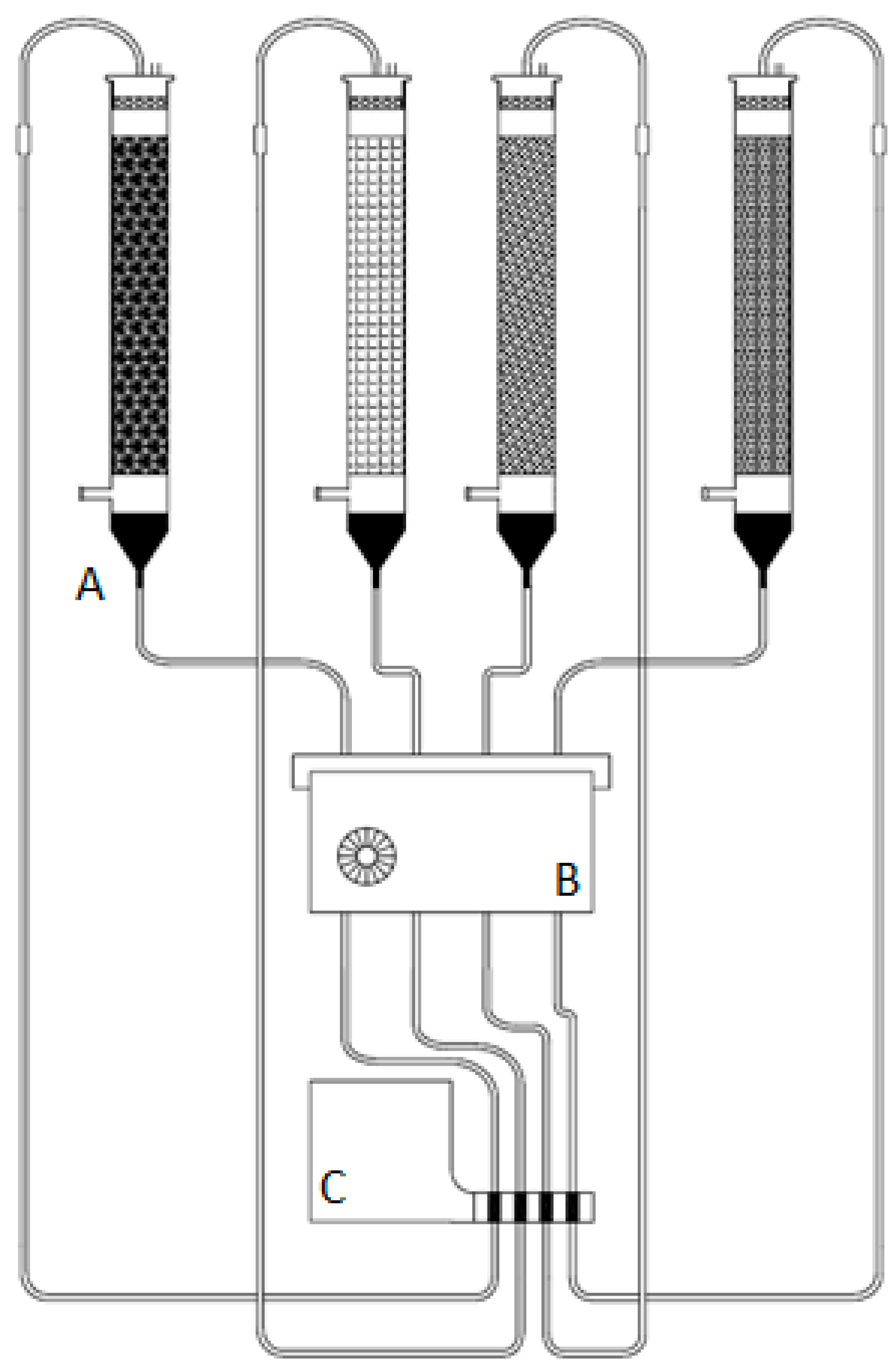

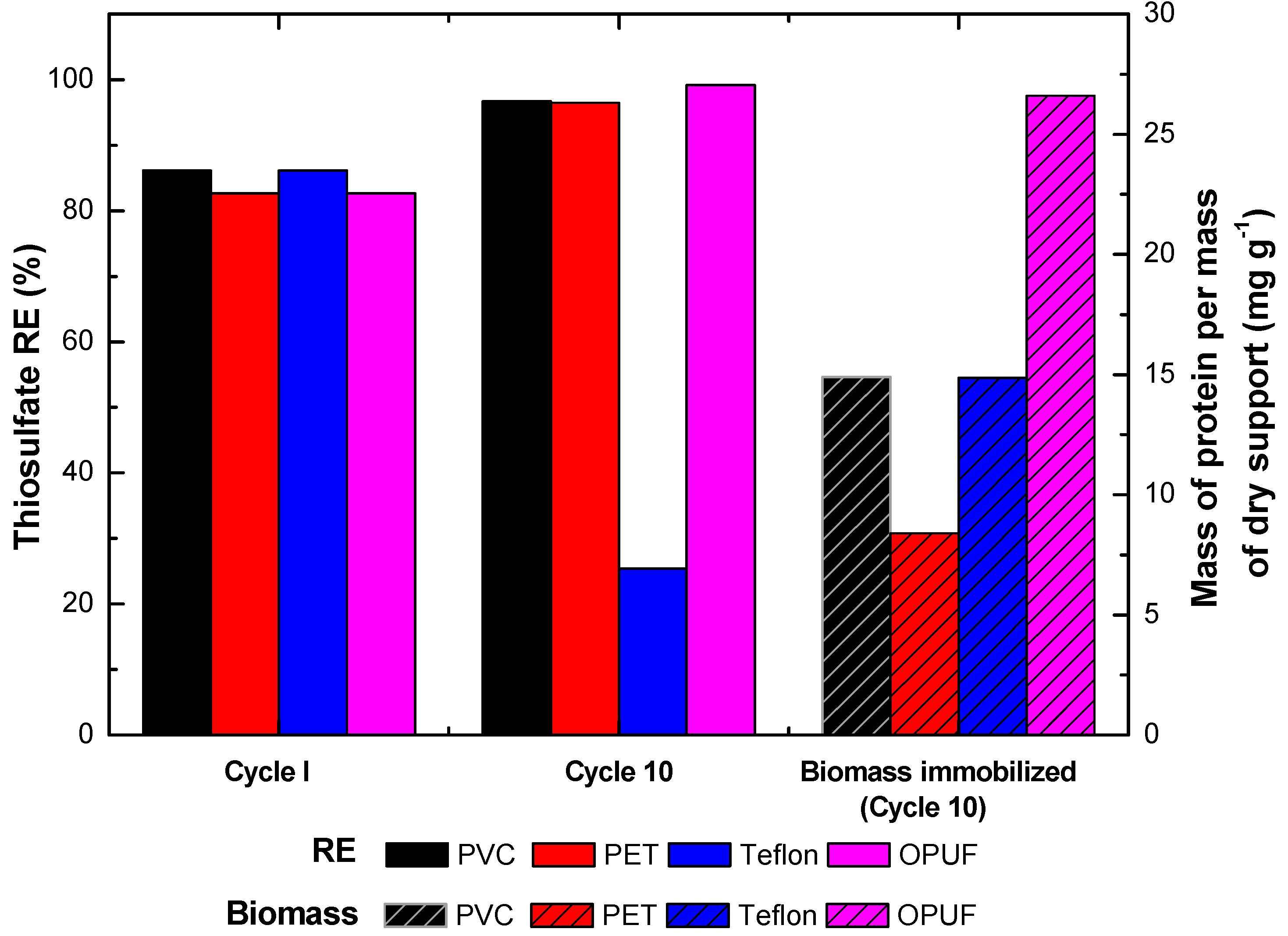
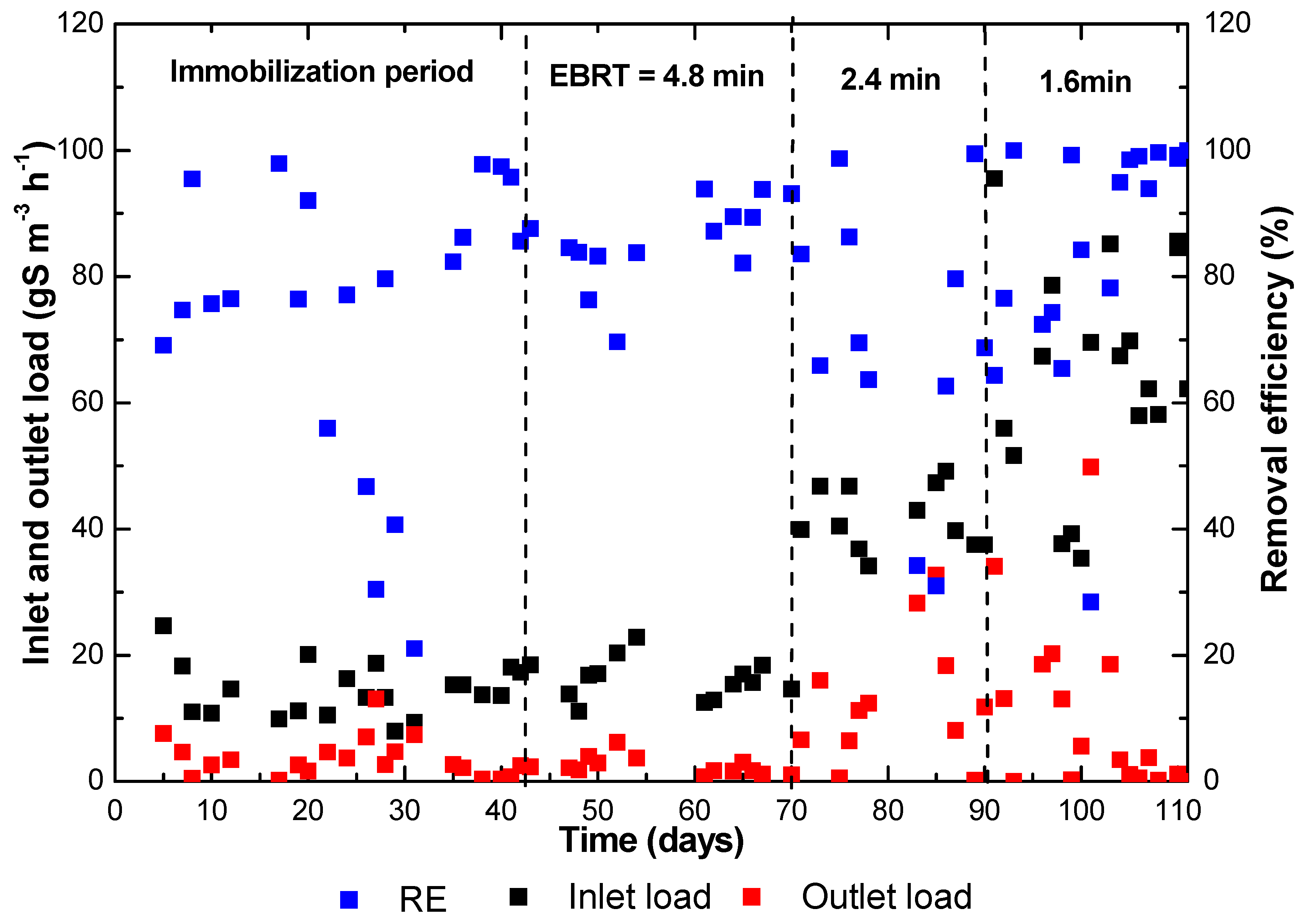
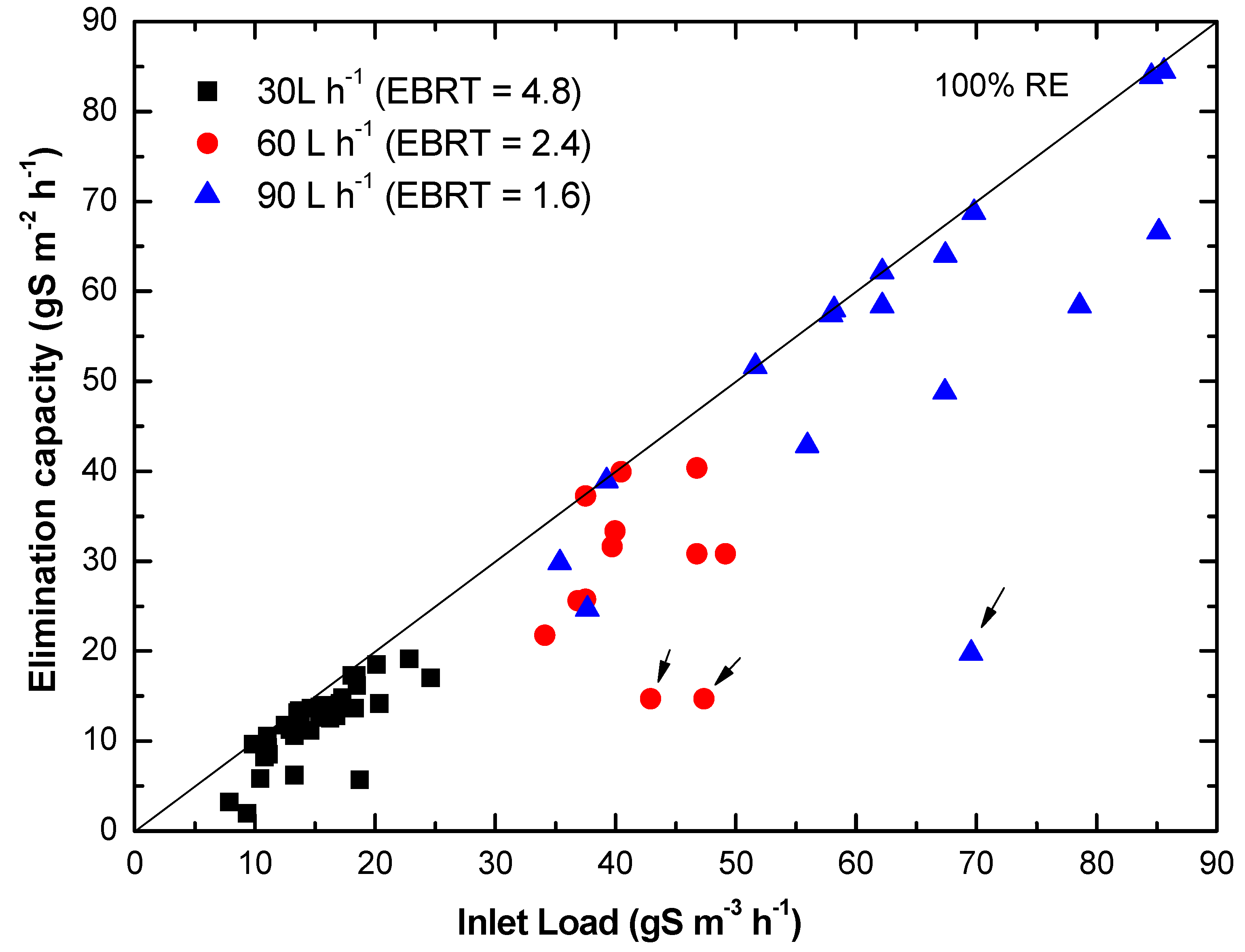
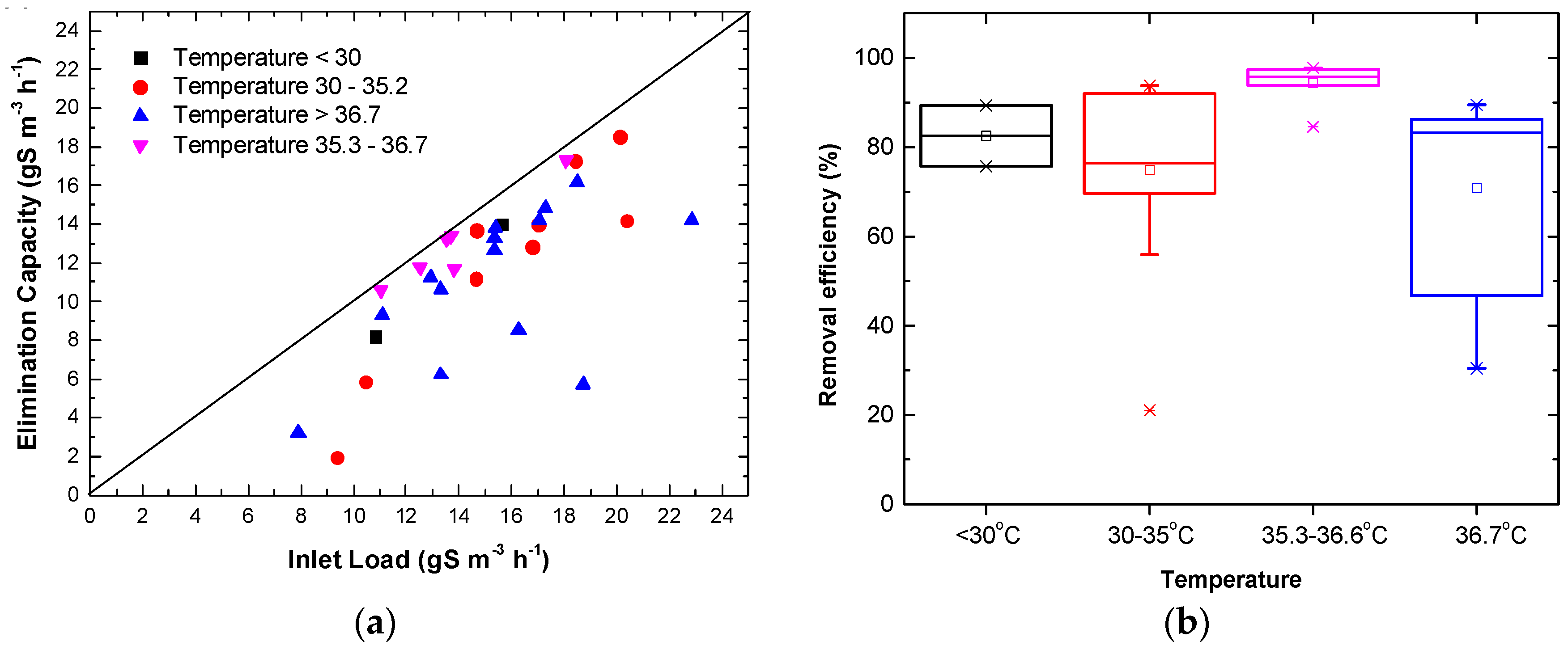
| Packing Material | Specific Surface Area (m2·m−3) | Density (kg·m−3) | Porosity (%) | Reference |
|---|---|---|---|---|
| Lava rocks | 200 ± 50 | - | - | [7] |
| Plastic fibers | 650 ± 50 | - | - | [7] |
| Open pore polyurethane foam | 600 | 35 | 97 | [8] |
| Polypropylene pall rings | 320 | 110 | 88 | [9] |
| Metallic Pall rings | 515 | 520 | - | [10] |
| Honeycomb | 620 | - | 88 | [11] |
| Material | Surface Area (m2·g−1) |
|---|---|
| PVC | 0.432 |
| PET | 0.443 |
| Teflon | 0.909 |
| OPUF | 6.694 |
| Parameter | PVC Pieces Present Study | OPUF [18] |
|---|---|---|
| Energy source for immobilization | H2S from biogas | Na2S2O3·5H2O |
| Nitrate concentration (g·N-NO3−·L−1) | 0.25–8.0 | 0.25–2.0 |
| EBRT (min) | 1.6, 2.4 and 4.8 | 1.6, 2.9 and 6.2 |
| TLV (m·h−1) | 8–11 | 4.4, 7.4 and 11 |
| Temperature (°C) | 24–40 | 22–47 |
| H2S Inlet Load (gS·m−3·h−1) | 8–108 | 2–16 |
| Elimination Capacity (gS·m−3·h−1) | 84.4 | 14 |
| Removal Efficiency (%) | 95.72 (IL = 67.38 ± 17.74 gS·m−3·h−1), EBRT = 1.6 min) | 98 (IL = 6.13 ± 0.49 gS·m−3·h−1, EBRT = 2.9 min) |
© 2019 by the authors. Licensee MDPI, Basel, Switzerland. This article is an open access article distributed under the terms and conditions of the Creative Commons Attribution (CC BY) license (http://creativecommons.org/licenses/by/4.0/).
Share and Cite
Tayar, S.P.; Guerrero, R.d.B.S.; Hidalgo, L.F.; Bevilaqua, D. Evaluation of Biogas Biodesulfurization Using Different Packing Materials. ChemEngineering 2019, 3, 27. https://doi.org/10.3390/chemengineering3010027
Tayar SP, Guerrero RdBS, Hidalgo LF, Bevilaqua D. Evaluation of Biogas Biodesulfurization Using Different Packing Materials. ChemEngineering. 2019; 3(1):27. https://doi.org/10.3390/chemengineering3010027
Chicago/Turabian StyleTayar, Samir Prioto, Renata de Bello Solcia Guerrero, Leticia Ferraresi Hidalgo, and Denise Bevilaqua. 2019. "Evaluation of Biogas Biodesulfurization Using Different Packing Materials" ChemEngineering 3, no. 1: 27. https://doi.org/10.3390/chemengineering3010027
APA StyleTayar, S. P., Guerrero, R. d. B. S., Hidalgo, L. F., & Bevilaqua, D. (2019). Evaluation of Biogas Biodesulfurization Using Different Packing Materials. ChemEngineering, 3(1), 27. https://doi.org/10.3390/chemengineering3010027





